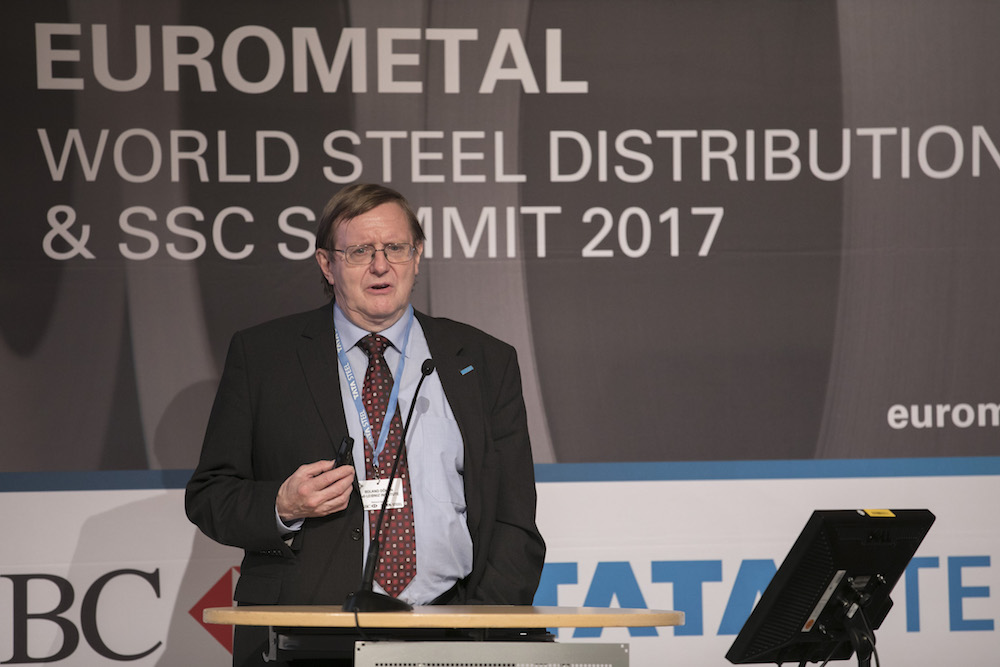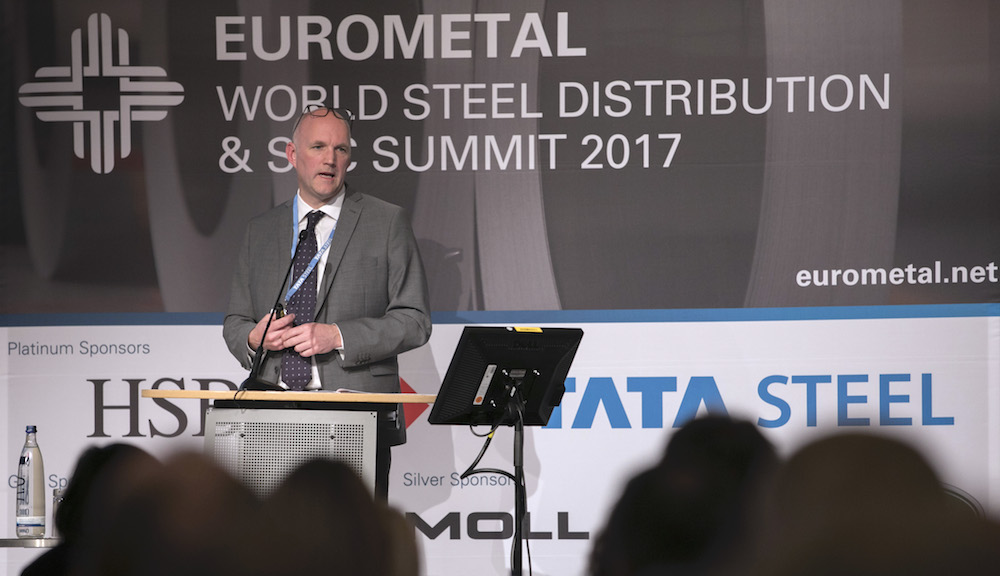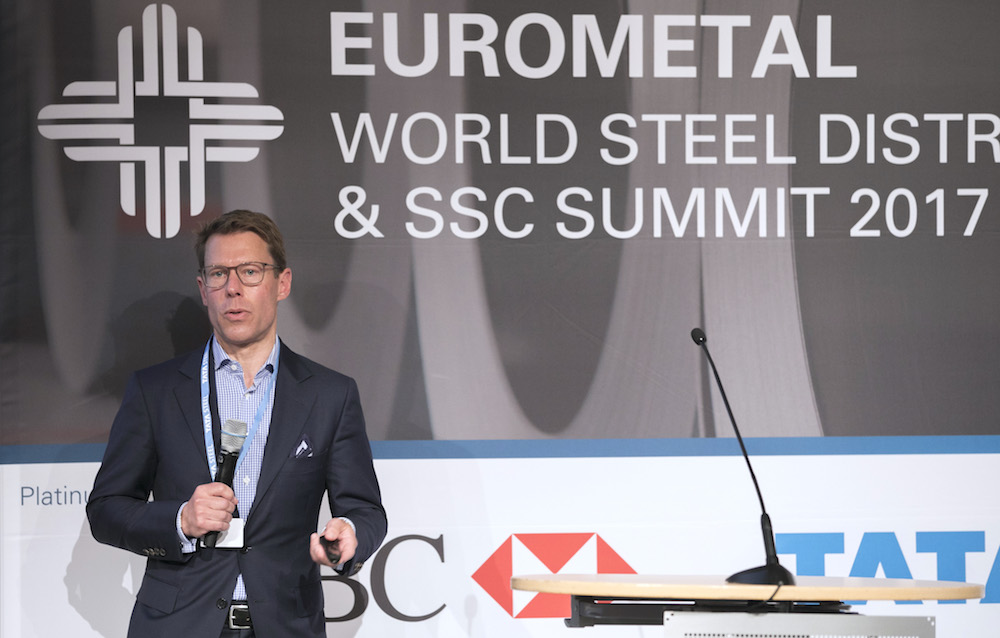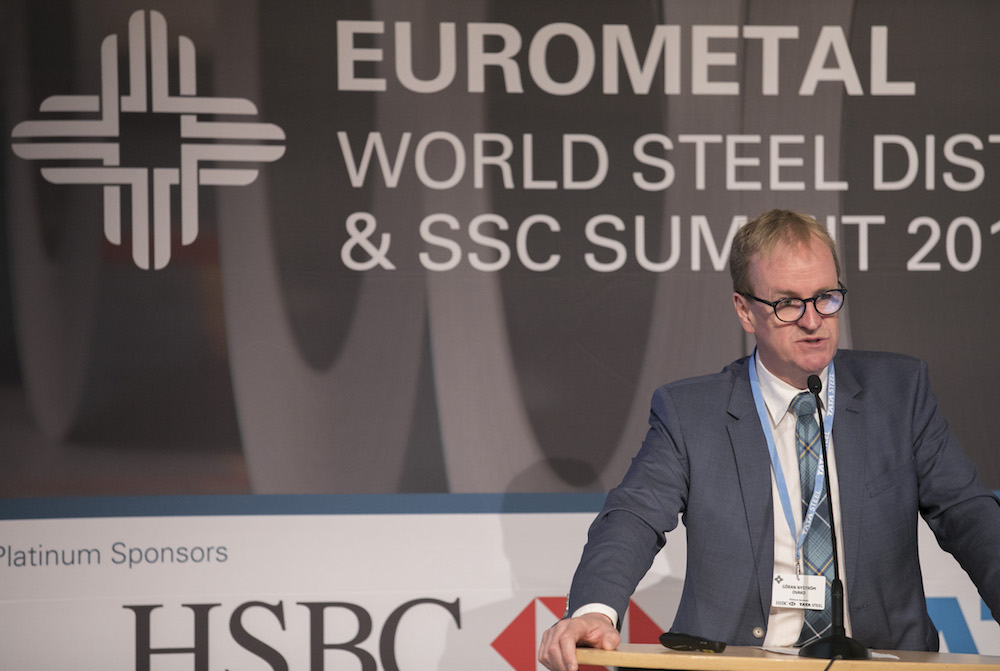Die Welt zu Gast am Rhein
Knapp 150 Teilnehmer aus Stahlproduktion, -Verarbeitung und -distribution trafen sich Mitte Mai auf Einladung des europäischen Stahldistributionsverbands Eurometal zu einer internationalen Konferenz in Düsseldorf. Moderiert wurde die Veranstaltung von Eurometai-Präsident und CEO von Tata Steel Distribution Europe Dr. Jens Lauber, sowie von Eurometal Vice President und BDS-Vorstand Oliver Ellermann.
Themen der zweieinhalbtägigen Konferenz waren die gesamtwirtschaftlichen Entwicklungen mit ihren Auswirkungen auf die globalen Stahlmärkte und Veränderungen im weltweiten Stahlhandel, insbesondere vor dem Hintergrund zunehmender Antidumpingmaßnahmen.
Auch die Veränderungen der Geschäftsmodelle innerhalb der Stahldistribution, die Perspektiven verschiedener stahlintensiver Abnehmerbranchen sowie das Thema Digitalisierung entlang der Wert-schöpfungskette spielten eine wichtige Rolle. Abgerundet wurde das Programm durch zwei Betriebsbesichtigungen, zum einen bei Tata Steel Hille & Müller in Düsseldorf, zum anderen bei der Europipe Group in Mülheim an der Ruhr.

Global industry at ‘inflection point’: Basson

The global steel industry has reached “an important inflection point” that requires steelmakers to consider new strategies to survive, according to World Steel Association Director General Edwin Basson.
Speaking Thursday during the EUROMETAL World Steel Distribution & SSC Summit in Dusseldorf, Basson said current global installed steel capacity — at some 2.39 billion mt — is already enough to meet supply requirements through 2035.
Finished steel demand is likely to be around 1.535 billion mt in 2017, up only 1.3% from the previous year, and nearly 1.549 billion mt in 2018, an increase of 0.9% year on year, according to worldsteel. Strong steel demand growth in developing countries will offset stabilizing demand in developed economies, but it means mostly flat overall global demand for likely the next two decades or more, Basson said.
Combine those factors with declining trends in steel use — due in part to increased production of high-strength, lightweight steels and a sharper focus on reuse and recycling — and the outcome is clear. “We believe that steel demand, in terms of volume, has reached an important inflection point,” he said. “It will continue to grow, but the growth … is going to be much slower than it has been in the past two decades.”
Basson said a ton of steel remains in use for an average of 47 years in Europe, 44 in the US and less than 40 in China. The global average is around 45 years. With technological improvements resulting in less steel being required in many applications and yielding longer lifespans for the material, those averages are likely to increase, he said.
“If it’s only five years that we’re extending the life of steel, it means that we’re pushing that demand forward five years,” Basson said. “As steelmakers and users of steel, we should begin to plan around this [knock-on effect].”

In addition, as emerging economies have developed their own domestic steel industries and global overcapacity has pushed tons into the export market, trade case filings in the US and Europe, in particular, have increased in volume in recent years. Basson cautioned that such a strategy is unlikely to be sustainable.
“Protectionism can help us in the short term … but it cannot in the long term provide stability in an industry that is driven by global forces,” he said.
Christopher Davis, S&P Global Platts

€500/mt likely to be the cut off point for HRC fall: sources

The European coil market has been slipping downwards, but delegates at the EUROMETAL World Steel Summit conference in Dusseldorf did not expect a prolonged fall, with many suggesting €500/mt ex-workks will be the cut off point for hot rolled coil.
While pressures are building in central and eastern Europe, traders noted the withdrawal of Russia from the import market and the potential for the declining coil prices to invigorate the EC’s investigation into HRC imports.
“I don’t see the market dropping considerable so it won’t go below €500/mt, maybe €510 but not much lower,” a mill source said. He said he was still “easily” able to achieve sales at around €530-540/mt in Germany, but accepted the market is on a downward track.
A trading source said he expects the major Europeans to return below €500/mt, but agreed that pressure from imports was slowing. He said the biggest cause for the European HRC market to fall was the availability of Russian HRC once the preliminary duties were not imposed. But he noted “the window for buying from Russia is now closing” as Russian mills have now largely withdrawn from the market.
He said many had bought in big quantities from Russia at €480-490/mt CIF Antwerp, but the lead times meant the trade flow was no longer viable.
In January, the EC enforced registration of Brazilian and Russian HRC but, as preliminary duties were not imposed, material could again be bought without threat of duties. As a result, there was a window of opportunity for people to buy.
But while preliminary measures were not imposed, buyers said they were concerned final duties could still be imposed and made retroactive. “The EC can announce registration again at any point,” a buy-side source said. The retroactive period can be applied for three months before the October 6 final decision which means many are nervous that HRC arriving in July will be susceptible to measures.
In his presentation, Alexander Julius of the German trading group Macrometal said: “It was the first case where the European Commission really considered the case of the end users, and the first case where they faced a major objection from end users.” But he said the EC had made €500/mt the effective cut off point, so if the market falls back below that level he said it was more likely that final duties would be imposed.
Peter Brennan, S&P Global Platts

European construction sector improved, but uncertainty looms

The European construction market has seen a reversal of fortunes lately, but overcapacity among the steel producers that serve the sector and political and economic uncertainty will continue to drag on fundamentals for some time, according to speakers at an industry event in Germany.
In a presentation Thursday at the EUROMETAL World Steel Distribution & SSC Summit in Dusseldorf, Gareth Beese – strategic development director for construction at British Steel – said construction has seen a progressive recovery in Europe and sentiment within the industry is positive.
Germany, in particular, has benefited from the upturn, according to Roland Dohrn, a professor of economic research at the RWI-Leibniz Institute.
“If you drive around in Germany, you will see a lot of cranes there,” Dohrn said, adding that he worries, though, whether data regarding the upturn is perhaps “a bit too good to be true.”
Margins remain thin for the companies that produce construction products like beams and rebar, and it’s a fragmented market with limited collaboration among participants, Beese said.
“There’s significant overcapacity still,” he said. “Producers have had to get used to operating plants at less than 100%.”
Dohrn said Europe’s economy performed well in the first quarter of 2017, which could underpin an upswing going forward. However, GDP growth for the region is predicted to be only around 1.9% in 2017 and 1.7% in 2018. Traditionally, a minimum of 2% growth has been necessary to stimulate significant additional steel demand and production, and Dohrn said the rule of thumb now has probably risen to even 3-3.5% GDP growth.
Beese said Brexit and its impact also continue to cloud the longer-term picture, not only for steel but from an economic standpoint, as well. “I think there’s a prolonged period of uncertainty for all of us,” he said.
One certainty he hopes for, though, is that Europe and the UK will remain post-Brexit trade partners. “We want and expect continued access to European markets and, quid pro quo, the UK market will remain open to European producers,” Beese said.
Christopher Davis, S&P Global Platts

Mergers present opportunities for smaller players

Representatives of some of the smaller European mills have welcomed potential mega mergers in the continent’s steel industry, suggesting there will be benefits to the sector and opportunities for their companies.
ArcelorMittal, Marcegaglia and Arvedi are involved in the final stages of the bidding process to acquire the Ilva works in Taranto, while ThyssenKrupp and Tata Steel are discussing a potential merger in moves most see as crucial to consolidating the European industry.
Speaking at the EUROMETAL World Steel Summit conference in Dusseldorf, Sebastian Bross of Salzgitter said mills like his, with around 5% market share in the strip sector, had already received increased interest as a result of the rumors surrounding competitors. “We would like to have a less fragmented market but if there are some big players there’s always a role for some smaller ones… We recognized that as soon as these rumors began going on about a joint venture between ThyssenKrupp and Tata Steel we saw customers coming to us… It’s no threat it’s actually more a chance for us,” he said.
Henrik Adam of Tata Steel Europe agreed overcapacity and a lack of consolidation was one of the structural issues facing the sector, but declined to say how many producers there should be in the flat steel market, saying: “more than one and less than ten.”
Another source from a smaller European mill agreed with Bross noting their company would benefit from the reduced number of players in the market as competition for business would decrease, while a desire of customers to create as diverse a supply chain as possible should push demand in their direction.
Peter Brennan, S&P Global Platts

EU wants to be a poster child for the WTO: Salzgitter

The European Union is too slow and too cautious in tackling dumping, according to Sebastian Bross of Salzgitter Flachstahl, who told the EUROMETAL World Steel Summit conference in Dusseldorf he did not understand the decision not to impose preliminary HRC duties.
Bross said the difference between the EU and the US was stark in its approach to trade barriers, pointing to the European Commission’s logic in making its conclusion to its preliminary investigation into imports of HRC from Russia, Brazil, Iran, Ukraine and Serbia.
“240 of the 250 pages showed there was dumping, but in the end there was no duty. I don’t really understand that… Compared to the US it’s slow, very limited, and from our perspective far too cautious. It feels that the EU wants to be a poster child for the WTO. We accept every rule and we’re pretty fair, but it means it takes a very long time [to impose duties] and you see how quickly this flow of material changes,” he said.
The launching of a section 232 investigation in the US has made European mills nervous as the US is a major export destination for the continent. Bross pointed out the potential distortions to global trade if the US stops importing and the implications for the European market, “Where does the material go, where does it find its new home? If you look at the slow progress in the EU you can assume it will end up here,” he said.
Salzgitter is benefiting from the good performance in the automotive sector which accounts for two thirds of its annual 3.3 million mt of strip production. But Bross said pressures remain as construction and tube demand is still weak and growth in European steel demand is benefiting importers rather than the domestic producers.
Peter Brennan, S&P Global Platts

European buyers require established imports: Macrometal

European import buyers purchased a lot of strip material from established suppliers China and Russia in the fourth quarter of 2016, despite ongoing anti-dumping duties and imposed duties, Alexander Julius, CEO of Macrometal, said at the EUROMETAL World Steel Summit conference in Dusseldorf Thursday.
“Despite accusations and ongoing accusations, imports have increased dramatically for metallic coated flats,” he said. As domestic suppliers were eyeing increases in the second half of the year, buyers turned to Russia and China to cover their requirements in the event of further increases, he said.
In fact, buyers bought more material than required, resulting in currently high stocks throughout Europe, he said.
While trade measures help create a level playing field, “excessive” action cause an uncertain environment for steel-using industries, according to Julius: in its current investigation into HRC imports from Brazil, Iran, Russia Serbia and Ukraine, the European Commission refused to impose provisional duties that would harm end-users.
“Established sources such as Russia cannot easily be substituted. They have become an integral part of EU manufacturers’ business model and competitiveness,” he said, suggesting import sources are essential as domestic mills are not prioritizing commodity grades.
“How can European manufacturers make a proper business planning with uncertain availability?” he asked, drawing up a worst case scenario in which manufacturing would have to partly move out of the EU.
Julius also questioned whether hot-dip galvanized tonnages from investigated countries could be supplied by domestic mills at competitive “transparent” price levels, pointing to the current move by mills towards effective pricing by removing extra price lists and giving a “custom-made” price. “It is very difficult for end-users to know where these effective prices are coming from,” he said.
He also alluded to defense measures elsewhere, such as the US, hurting European exporters. “We don’t only have a problem with imports, but also with exports.”
Laura Varriale, S&P Global Platts

EC may have cut countries from ADD investigation: sources

Serbia and Iran may have been removed from the European Commission’s investigation into hot rolled coil imports, according to sources attending the EUROMETAL Summit in Dusseldorf.
“The investigation is still ongoing. No decisions have been taken at this stage, so no comment from us at this point in time,” Kinga Malinowska, Press Officer for Trade at the European Commission, told S&P Global Platts via email Thursday.
Charles de Lusignan, Communications Manager at European steel producers’ association Eurofer, said the organization heard that Serbia could have been excluded, but had nothing to suggest this was the case for Iran.
When the European Commission said earlier this year it would not impose preliminary duties on imports from Brazil, Iran, Serbia, Russia and Ukraine, it said Serbia should not be cumulatively assessed with the other four countries: it was barely over the minimum market share threshold, at 1.04%, and average selling prices were considerably above the other countries in the investigation period, the commission said.
“It follows that protective measures are unnecessary with regard to the imports of HRF originating in Serbia,” the commission document, seen by Platts, said. At the time the commission also refused to comment on whether this meant Serbia had been excluded.
One legal source said Thursday it was evident from that document Serbia would be removed from the case. He also said the deadline for announcing definitive dumping duties could have been brought forward from October to August, though this could not be confirmed.
Serbia being removed from the case may have raised some eyebrows, as Chinese-owned mill HeSteel is said to be the most competitive player in the European market of late: recent offers have been heard at €470/mt delivered into south Germany and €485/mt delivered Ruhr, both of which are way below the €530-€540/mt ex-Ruhr level being quoted by western European mills.
Nevertheless, sources noted Serbia is a small player with limited volume impact, and many were surprised it was even named in the dumping investigation.
Most point to the reappearance of significant volumes of Russian HRC in the Antwerp import market as a more significant result of the European Commission’s decision not to impose preliminary anti-dumping duties. When announcing it would not impose duties, the EC said duties could have harmed end-users, as reported.
Peter Brennan, Annalisa Villa and Colin Richardson, S&P Global Platts

Ovako promotes machinable steels to distribution sector

Ovako is promoting its steel treatment technology for improved machinability as an example of an opportunity for distributors to participate in the value-added chain from an early stage.
The philosophy of the Swedish engineering steels producer was delivered by vice executive president and head of group marketing, Göran Nyström, at the recent EUROMETAL World Steel Summit in Düsseldorf, attended by Kallanish. Ovako continues to sell 85% of its production to end-users, “… but we would like to change that,” Nyström told the audience of mainly distributor and service centre managers.
Ovako faces the difficulty of having to service a wide range of customers with very different requirements for the special steels produced by the company. Such a delivery challenge for a mill “… brings opportunities for you distributors [… to act] as a buffer,” he said.
Nyström highlighted the role of Ovako’s M-Steel (M for ‘machinable’) as an example of [… potential] closer cooperation with distributors. The basis for the M-Steel concept is that non-metallic inclusions in steel are modified and controlled with calcium treatment. These inclusions are modified in a way to maximise machinability and to improve transverse fatigue strength. In this way, a protective layer is formed on the cutting tool during machining that very significantly reduces the wear on the tool and increases tool life.
The M-Steel concept allows 30% faster throughput for machined components, and can extend cutting tool life by 50%. “Tool suppliers are not keen to promote us, it takes half of their market,” Nyström quipped, and closed with the remark that “… we need distribution services to bring this innovation outside the Nordic region.”


